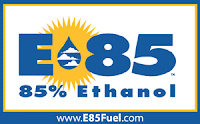The E85 Road Test
 A friend of mine bought a 2007 Chevy Avalanche LTZ a few weeks ago. He really likes his new truck, and doesn’t even complain about its gas mileage. According to him, it’s very comfortable (it has leather, XM radio, plenty of room inside, and enough room for everything that his family needs when they travel) and fits his needs perfectly.
A friend of mine bought a 2007 Chevy Avalanche LTZ a few weeks ago. He really likes his new truck, and doesn’t even complain about its gas mileage. According to him, it’s very comfortable (it has leather, XM radio, plenty of room inside, and enough room for everything that his family needs when they travel) and fits his needs perfectly.
He’s owned his truck for a few weeks, and after hearing all of the hype about E85 in the media (thanks to GM and Congress, mostly, plus the President’s push for alternative fuels to reduce our dependence on imported oil), he decided to try to fill up his flex fuel-capable Avalanche with a tank of E85, which is 85% ethanol and 15% gasoline. (Normal “gasoline” is up to 10% ethanol for air pollution reduction purposes, or E10).
In case you’ve been asleep for the past few years, allow me to introduce you to ethanol. Ethanol sold in the US is distilled primarily from corn, which is something the US is able to grow a lot of. There are a few problems with using ethanol as a motor vehicle fuel: diverting corn crops to be used in fuel production instead of food production causes corn prices to rise; there is also controversy about the amount of energy required to create ethanol from corn, and a lack of availability of gas stations selling E85.
I live in Pennsylvania, and there are seven service stations open to the public with E85 in the entire state. To find an E85 station near you, go to http://www.e85refueling.com/. The station that my friend went to is about 16 miles (30 minutes) from his house, and happened to be along the way he was traveling on the day he filled up with E85. When he got to the station, the pump was in a parking space-like location in a corner of the property with an old pump that did not have pay-at-the-pump capability. He filled up his tank for $2.359 (the going rate for regular unleaded at this station was $2.999 that same day), paid for his purchase, reset his trip computer, and hit the road.
At first, he didn’t notice anything different. His trip computer was reporting very similar fuel economy to what he experienced with gasoline – but soon, the last of the gasoline worked its way through the fuel system, and he was running on E85. The gas mileage dropped almost immediately. He reported that acceleration felt a little more brisk, but said that it may have been psychological instead, knowing that E85 has a higher octane than gasoline (typically between 100 and 110, versus 87 to 93 for gasoline), which allows the engine’s computer to alter ignition timing slightly with less risk of engine knock.
Halfway through his first tank, his mileage with E85 is about 12 miles per gallon; his average with gasoline on the tanks before this was around 15 miles per gallon, so he asked me to calculate the breakeven point at which ethanol’s lower price offsets its poorer fuel economy. He’s getting 26.1% better mileage with gasoline than with E85, but paying 27.1% more for gasoline than he did for E85. Therefore, it’s almost a wash for him, plus he can sleep more peacefully at night knowing that he’s not fattening the coffers of the major oil companies or countries unfriendly to the US, and is releasing cleaner exhaust into the atmosphere. In fact, he claimed that the exhaust emissions smelled not unlike Pam cooking spray. (I don’t recommend sniffing the exhaust fumes regularly, E85 or not!)
If you’d like to calculate your own breakeven point for ethanol pricing (independent of whatever political or environmental benefits using E85 might have), use the following formula to determine what price E85 should be less than or equal to:
E85 breakeven price = E85 mpg × Gasoline price ÷ Gasoline mpg
I used my new equation with my friend’s situation, and if he’s able to get 12 mpg from E85 and pay what he paid, it works out in his favor because the breakeven would be $2.399 per gallon, which is more than he paid for E85, assuming he doesn’t have to drive out of his way to fill up on E85.
If you can actually get some hands on E85, AND you have a flex fuel-capable car or truck (your gas cap should tell you if you don’t know), give it a try!




